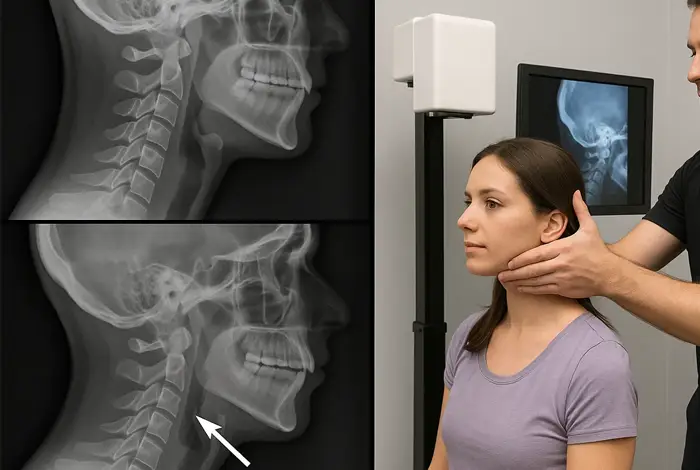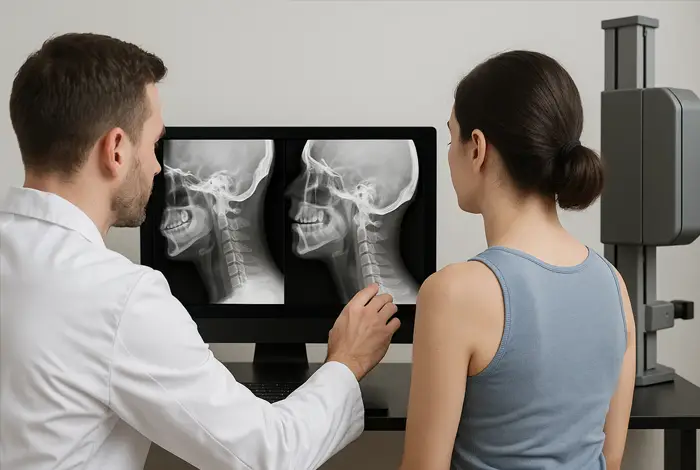Upper cervical chiropractors specialize in the delicate area where the skull meets the spine specifically the C0–C1–C2 region. Precise alignment here is critical, but without the right diagnostic tools, it’s easy to miss subtle instabilities that may be the root cause of a patient’s symptoms.
That’s where Digital Motion X-Ray (DMX) comes in.
At DMX Miami, we work closely with upper cervical doctors, NUCCA, AO, Blair, and other structural chiropractic professionals who want the most accurate motion imaging of their patients’ neck function. Our scans help confirm or rule out instability, guide treatment, and support better long-term outcomes.
Why Upper Cervical Instability Is So Hard to Detect
The atlanto-occipital (C0–C1) and atlanto-axial (C1–C2) joints allow for a wide range of motion but they rely entirely on ligaments for stability, not discs.
When these ligaments are stretched or damaged (due to trauma, sports, car accidents, or genetic hypermobility), symptoms can appear such as:
- Head pressure or fogginess
- Eye tracking issues or dizziness
- Neck pain with movement
- Vagal symptoms (heart palpitations, nausea, fatigue)
- Poor response to traditional chiropractic care
And yet… static X-rays and MRIs show nothing.
Only a motion-based study like DMX can confirm what’s really going on.
What DMX Offers Upper Cervical Doctors
Digital Motion X-Ray (DMX) captures:
- Full-motion images of C0–C7 in real time (30 frames/sec)
- Vertebral tracking in flexion, extension, rotation, lateral flexion
- Evidence of abnormal motion or joint subluxation
- Alar and transverse ligament instability
- Stress patterns that correlate with patient symptoms
This allows upper cervical chiropractors to:
- Confirm suspected instability before care
- Choose the right vector, angle, and force
- Identify which levels need the most attention
- Avoid adjusting unstable segments prematurely
- Validate pre- and post-treatment progress
DMX + Chiropractic = Precision Care

Chiropractic techniques like NUCCA, Blair, Atlas Orthogonal, and Knee Chest depend on:
- Measurable misalignment
- Consistent anatomical landmarks
- Postural and motion correlation
- Knowing whether the joint is fixated or hypermobile
DMX allows you to see:
- When “misalignment” is actually instability
- Whether an area needs correction or stabilization first
- Whether other levels are compensating
- How the spine moves dynamically not just statically
It’s the difference between guessing and knowing.
How DMX Miami Works With Chiropractors
We support:
- Chiropractors referring patients for instability scans
- Out-of-town doctors receiving reports + motion videos
- Treatment planning discussions based on findings
- Post-treatment DMX for outcome tracking
- Expert consultation and care coordination
All patients receive:
- Full report with radiologist interpretation
- High-resolution motion video
- English & Spanish communication
- Concierge appointment support
We Work With Clinics Around the World
Whether you’re in:
- Miami, Fort Lauderdale, Tampa, Orlando, or South Florida
- Anywhere in the U.S. (New York, Texas, California, Illinois)
- Latin America (Colombia, DR, Puerto Rico, Panama)
- Europe (UK, Spain, Germany, France)
You can refer patients to DMX Miami for expert-level instability assessment.
Help Your Patients Get the Answers They Deserve
If you suspect upper cervical instability in your patients but need objective evidence, we can help.
Call 305-275-7475 or book your appointment online

Dr. Rodolfo Alfonso, D.C.
Dr. Mark N. Berry, D.C.
Sunset Chiropractic and Wellness
8585 Sunset Dr. STE 102
Miami, Florida 33143
305-275-7475
Schedule Your DMX Today
You’ve been searching for answers. Now you can see the cause of your symptoms in motion.
Visit us in Miami
Call 305-275-7475
Request an appointment online
Follow us on Instagram, Facebook, and YouTube for updates, patient success stories, and expert insights on neuropathy treatment!
